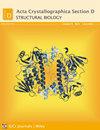用于蛋白质 X 射线晶体学结构测定的深度学习地图分割。
IF 2.6
4区 生物学
Q2 BIOCHEMICAL RESEARCH METHODS
Acta Crystallographica. Section D, Structural Biology
Pub Date : 2024-07-01
Epub Date: 2024-06-27
DOI:10.1107/S2059798324005217
引用次数: 0
摘要
在利用单波长反常衍射 X 射线数据求解蛋白质结构时,通常需要通过迭代电子密度修改来改进从反常散射子结构相位得到的初始相位。本手稿提出使用卷积神经网络(CNN)对初始实验相位电子密度图进行分割。报告结果表明,主要利用蛋白质数据库中的 X 射线数据生成的数千张电子密度图进行监督学习训练的 U 型网络架构卷积神经网络可以改进当前的密度修正方法。本文章由计算机程序翻译,如有差异,请以英文原文为准。
Deep-learning map segmentation for protein X-ray crystallographic structure determination.
When solving a structure of a protein from single-wavelength anomalous diffraction X-ray data, the initial phases obtained by phasing from an anomalously scattering substructure usually need to be improved by an iterated electron-density modification. In this manuscript, the use of convolutional neural networks (CNNs) for segmentation of the initial experimental phasing electron-density maps is proposed. The results reported demonstrate that a CNN with U-net architecture, trained on several thousands of electron-density maps generated mainly using X-ray data from the Protein Data Bank in a supervised learning, can improve current density-modification methods.
求助全文
通过发布文献求助,成功后即可免费获取论文全文。
去求助
来源期刊

Acta Crystallographica. Section D, Structural Biology
BIOCHEMICAL RESEARCH METHODSBIOCHEMISTRY &-BIOCHEMISTRY & MOLECULAR BIOLOGY
CiteScore
4.50
自引率
13.60%
发文量
216
期刊介绍:
Acta Crystallographica Section D welcomes the submission of articles covering any aspect of structural biology, with a particular emphasis on the structures of biological macromolecules or the methods used to determine them.
Reports on new structures of biological importance may address the smallest macromolecules to the largest complex molecular machines. These structures may have been determined using any structural biology technique including crystallography, NMR, cryoEM and/or other techniques. The key criterion is that such articles must present significant new insights into biological, chemical or medical sciences. The inclusion of complementary data that support the conclusions drawn from the structural studies (such as binding studies, mass spectrometry, enzyme assays, or analysis of mutants or other modified forms of biological macromolecule) is encouraged.
Methods articles may include new approaches to any aspect of biological structure determination or structure analysis but will only be accepted where they focus on new methods that are demonstrated to be of general applicability and importance to structural biology. Articles describing particularly difficult problems in structural biology are also welcomed, if the analysis would provide useful insights to others facing similar problems.
 求助内容:
求助内容: 应助结果提醒方式:
应助结果提醒方式:


